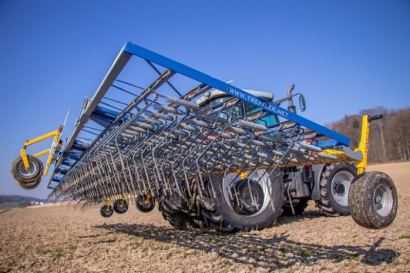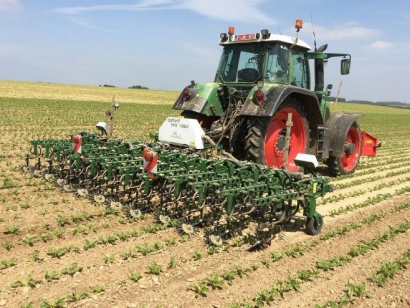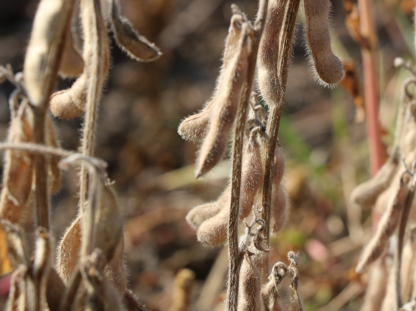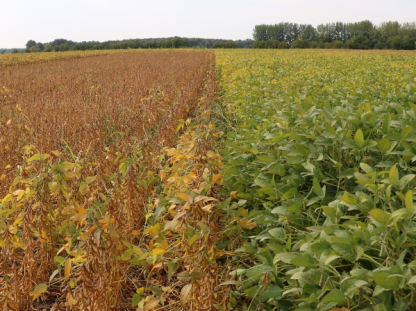Weed control: an important task in organic soybean production
The area devoted to soybean cultivation in Hungary has expanded in recent years, today covering some 60,000 ha. Organic soybean cultivation, meanwhile, has almost doubled in area, to around 1,800 ha.
However, due to unfavourable growing seasons and the inexperience of farms, yield averages have fluctuated (1.8-2.9 tons/ha). The dynamic rate of expansion has therefore stalled for the time being, despite the fact that in order to reduce the country’s dependence on protein imports, the National Protein Feed Program has set a target of 100,000 ha, to be reached within the next few years. It is therefore important to develop cultivation technology, and to test different varieties in Hungarian conditions, in order to achieve the optimal quantity, quality and security of yields.
The Hungarian Research Institute of Organic Agriculture (ÖMKi) has been conducting small-plot and on-farm soybean experiments since 2013. The role of soybean cultivation in organic farming may also increase, since it is a valuable source of protein, reducing the preponderance of grains in crop rotation, and is also nitrogen-fixing. In our experience, it is less susceptible to disease and, apart from certain species of lepidoptera, the occurrence of pests is not significant either. According to the principle of organic farming, farms should strive as far as possible to establish self-contained resource loops, meaning that the greatest possible quantity of feed should be produced on-farm. Soybean yields are mostly limited by drought and a tendency to suffer from weed growth. As changes in green regulations also affect conventional soybean growing areas, effective weed control without herbicide use is also becoming important for conventional soybean farms. We present here a weed control technology that has been implemented on the farm of one of ÖMKi's on-farm experimental partners, on the basis of several years’ experience in soybean cultivation.
Agricultural techniques for successful weed control at Organic Food Ltd. in West Hungary
The farm and its legal predecessor have been engaged in organic food production since 2002. Soybean cultivation was already being tried in 2003-2004, but owing to a lack of appropriate machinery – a suitable seed drill, for instance – they had little success. Starting in 2008, soybeans were sown with a seed drill at a row spacing of 48 cm, then from 2011, the farm switched to 76 cm row spacing. Due to the inter-row cultivation of sweetcorn, the constant reassembly and adjustment of the existing equipment was time consuming. During soil preparation, the autumn ploughing was followed by disc-harrowing then tine harrowing. The real technological shift, however, began in 2014.
Sowing time
The tried and tested sowing time is early to mid-May, so that the seed usually lands in warm, moist soil and germinates in 4-5 days. This rapid initial development is also excellent at controlling weeds.
Variety selection
The main variety on the farm is the ES Mentor, which has a shorter growing season and so, despite the later sowing time, can still be harvested in time, in mid to late September.
Technological changes
From 2014, the previous 48 or 76 cm row spacings were replaced with a 50 cm row spacing, the most efficient spacing for soybeans, which could be achieved on the farm thanks to the Accord Optima seven-row seed drill. By increasing the density of units sown, a good sowing quality can be achieved, and the exact number of plants specified (550-600,000 plants/ha).
During soil preparation, the last tool to be used before sowing is the rotary harrow, with which a seedbed can be prepared with an even depth of 10-12 cm, which is also advantageous during harvesting since it makes possible the harvesting of lower pods, resulting in less waste.
The farm also regularly uses organic manure and green manure mixtures. Soil bacteria (containing amongs others Rhizobium japonicum species) have been used for several years. They are applied as soon as possible before sowing, so that the bacteria are already working effectively in the soil when the soy is sown.
Untreated seed was previously inoculated with a local inoculum powder called Iregi, containing ground soya roots. Farm-saved seed was only used in 2015, and did not prove a great success due to germination problems. In the following years, the farm returned to sowing exclusively sealed, pre-inoculated seeds, with which they have had excellent germination rates.
Nurturing soy
Early weed control
3-4 days after sowing, but before soy germination, when weed seedlings are at the four-leaf stage, the farm uses a so-called rotary weeding harrow.
The 5-6 cm sowing depth enables pre-germination weeding at the appropriate depth. Pre-germination harrowing with a comb harrow was previously the preferred method on the farm, but this is now also done with a rotary weeding harrow. It is recommended to cultivate the soil more than once before sowing, during the spring, to combat weeds. Comb harrowing is also effective at this task before sowing.
Another practical tip: it is not necessary to use a very fine-grained seedbed. With the right seed drill, it is possible to sow properly in a slightly clumpier seed bed, while this can delay the emergence of weeds.
Inter-row cultivation
When the seedlings are at the six-leaf stage, the Schmotzer row crop cultivator can be used, equipped with rotary harrow discs.
Until 2012, inter-row cultivation was performed with a star-wheel hoe on the farm between two and four times, depending on that year’s needs. In 2013, they bought a Schmotzer-type inter-row cultivator with goose foot knives, and plastic star wheels that could be used in the rows as well. This device has excellent results against germinating and one- or two-leaf weeds, but is only effective if applied at the appropriate time.
In addition to mechanical weeding by machines, manual plant care is sometimes required. Occasionally, 8-10 people were able to partially weed out areas that could no longer be hoed with the machine. In 2016, in addition to machine inter-row cultivation, the entire area of soybean cultivation was completely cleared of weeds with the help of 25-30 people. In 2020, there was no need for manual plant care, thanks to improved mechanical weed control.
Harvest
A grain-threshing combine harvester is used for harvesting. Since the autumn of 2013, they have been able to clean and dry the harvested crop using their own equipment, so fortunately they can start harvesting at the optimal time. This step has also brought significant improvements in terms of quality and quantity.
Overall, the low weed pressure does not hinder either the development of soybeans or the harvest, contributing significantly to average yields of more than 3 tonnes per hectare on the farm, which have been stable for several years.
Tamás Gergye, farm manager at Organic food Ltd. and Dr Éva Hunyadi Borbélyné, research lead at ÖMKi




.jpg)







